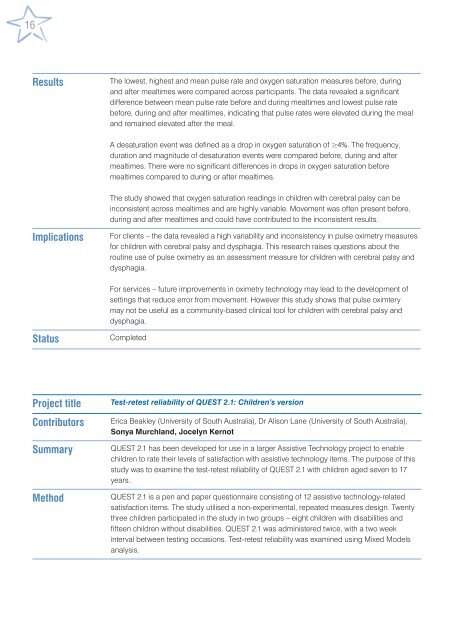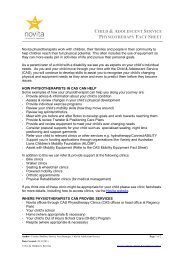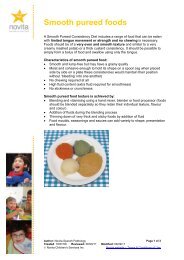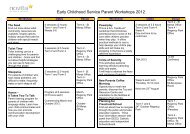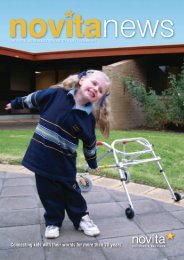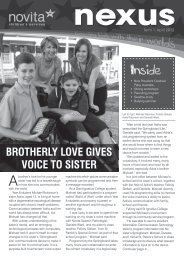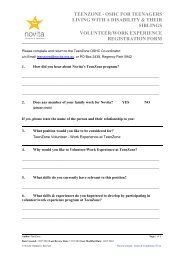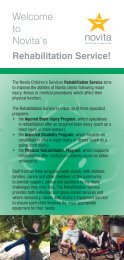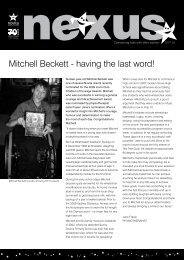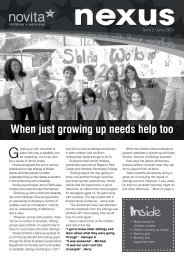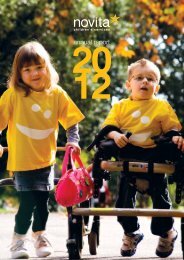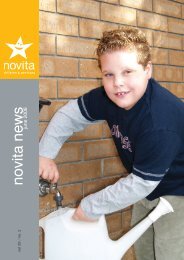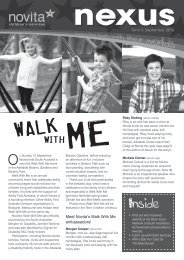Novita Research Report - 2004 to 2007 - Novita Children's Services
Novita Research Report - 2004 to 2007 - Novita Children's Services
Novita Research Report - 2004 to 2007 - Novita Children's Services
- No tags were found...
You also want an ePaper? Increase the reach of your titles
YUMPU automatically turns print PDFs into web optimized ePapers that Google loves.
16ResultsThe lowest, highest and mean pulse rate and oxygen saturation measures before, duringand after mealtimes were compared across participants. The data revealed a significantdifference between mean pulse rate before and during mealtimes and lowest pulse ratebefore, during and after mealtimes, indicating that pulse rates were elevated during the mealand remained elevated after the meal.A desaturation event was defined as a drop in oxygen saturation of ≥4%. The frequency,duration and magnitude of desaturation events were compared before, during and aftermealtimes. There were no significant differences in drops in oxygen saturation beforemealtimes compared <strong>to</strong> during or after mealtimes.The study showed that oxygen saturation readings in children with cerebral palsy can beinconsistent across mealtimes and are highly variable. Movement was often present before,during and after mealtimes and could have contributed <strong>to</strong> the inconsistent results.ImplicationsFor clients – the data revealed a high variability and inconsistency in pulse oximetry measuresfor children with cerebral palsy and dysphagia. This research raises questions about theroutine use of pulse oximetry as an assessment measure for children with cerebral palsy anddysphagia.For services – future improvements in oximetry technology may lead <strong>to</strong> the development ofsettings that reduce error from movement. However this study shows that pulse oximterymay not be useful as a community-based clinical <strong>to</strong>ol for children with cerebral palsy anddysphagia.StatusCompletedProject titleContribu<strong>to</strong>rsSummaryMethodTest-retest reliability of QUEST 2.1: Children’s versionErica Beakley (University of South Australia), Dr Alison Lane (University of South Australia),Sonya Murchland, Jocelyn KernotQUEST 2.1 has been developed for use in a larger Assistive Technology project <strong>to</strong> enablechildren <strong>to</strong> rate their levels of satisfaction with assistive technology items. The purpose of thisstudy was <strong>to</strong> examine the test-retest reliability of QUEST 2.1 with children aged seven <strong>to</strong> 17years.QUEST 2.1 is a pen and paper questionnaire consisting of 12 assistive technology-relatedsatisfaction items. The study utilised a non-experimental, repeated measures design. Twentythree children participated in the study in two groups – eight children with disabilities andfifteen children without disabilities. QUEST 2.1 was administered twice, with a two weekinterval between testing occasions. Test-retest reliability was examined using Mixed Modelsanalysis.


